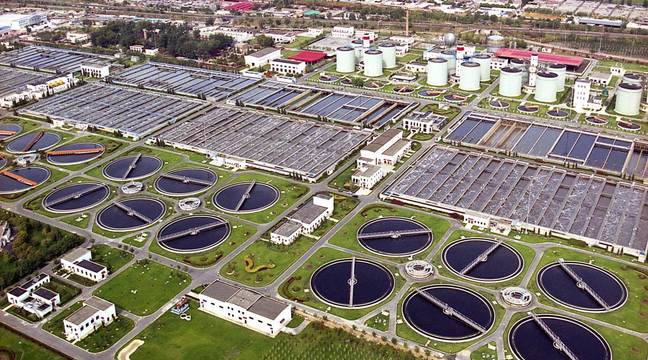
当前课程知识点:Water and Wastewater Treatment Engineering: Biochemical Technology > Chapter 5 Wastewater Anaerobic Biological Treatment Process > Section 5.2 Anaerobic digester > Section 5.2 Anaerobic digester
返回《Water and Wastewater Treatment Engineering: Biochemical Technology》慕课在线视频课程列表
返回《Water and Wastewater Treatment Engineering: Biochemical Technology》慕课在线视频列表
同学们好!现在我们开始学习第5章的第2节,厌氧消化池
这一节的主要内容有三个,一是消化池的类型与构造
第二是消化池的设计计算,第三是沼气的收集与利用
我们看第一节消化池的类型与构造,我们首先
来看一下消化池的应用范围
一般来说,主要是用于处理剩余污泥
但是最近,也有一些人用类似于消化池的工艺
去处理含有高固体含量的有机废水
厌氧消化过程的主要作用
是将进料中或者说是污泥中部分的有机物转变为沼气
同时将部分的有机物,转化成为稳定性较好的一些腐殖质
或者是一些其他的有机物,提高污泥的脱水性能
最终的结果,可以减小污泥的体积,大概是一半左右
同时由于在消化池中间的停留时间通常比较长
或者有的时候还会采用温度比较高的这种消化工艺
可以对污泥中间的一些致病的微生物进行灭活
从分类上来看,我们有不同的分类的方式
我们最简单的分类呢,是按照形状来分
可以分成圆柱形、椭圆形,有的时候我们也称为卵形
或者说是龟甲形,后面我们都会有具体的图片
按照池顶结构,我们可以分为,固定盖式的,或者是浮动盖式的
按照运行方式来说,我们可以分为传统的消化池和高速的消化池
这张图给出了传统厌氧消化池的一个基本的结构示意图
我们可以看到,它的最大的特点是在消化池内,会分层
在底部是已经消化成熟的熟污泥层
中间是正在进行反应的反应层
在上部会有一部分是上清液,上面污泥沉到底部
而上清液在上部,最上面可能会形成一层浮渣层
这是由于,厌氧消化中间会有大量的沼气气泡产生
沼气气泡呢,会夹带一些这个污泥的絮体
那么在上清液的表面,形成一层浮渣层
整个消化池的最顶部,是作为沼气的气室
将沼气收集排出系统,传统的厌氧消化池
有的时候又称为低速消化池,通常没有加热和搅拌装置
它有明显的分层,容积的利用率是有限的
它的消化速率也比较低,停留时间相对要求比较长
早期的时候通常会在30天到90天这样的一个停留时间
对于传统的消化池来说,它的反应速率比较低
需要的停留时间很长,所以很多的研究者
就致力于去设法提高消化池的反应速率
缩短消化池的停留时间
因此增加了两个主要的措施
一个是对消化池里面的污泥呢,进行加温
所以我们采用这个加热器
另外一个,就是增加了这个搅拌器
它的特点就是缩短了停留时间,提高了反应速率
但是有一个问题就是,增加了搅拌装置以后
破坏了它的分层现象,也就不可能排除上清液
不能够使污泥得到浓缩,因此的话
有很多研究人员就开始把高速消化池和传统消化池结合在一起
或者说是串联在一起,在第一级,利用高速厌氧消化池
快速的对污泥进行降解,进行分解
在后端利用传统消化池,进行上清液的分离
这里给出的就是一个两级串联的厌氧消化池的一个工艺流程
可以看到,第二级主要是起沉淀和浓缩污泥的作用
可以分离上清液,二者的HRT的比值
通常是在1:1到4:1之间,关于厌氧消化池中间的加热
这是非常重要的,因为前面讲过
厌氧微生物最重要的是会受温度的影响
在两个适宜的温度段
它的消化速率,会得到很好的提高
一般我们有两种方式,第一种是在消化池内
利用蒸汽直接加热,这个的特点是设备相对简单
但是局部的污泥容易过热
可能会导致部分的厌氧微生物受到伤害
而且还会增加污泥中间的含水率
所以我们更常用的是在池外,间接加热
将污泥预热以后投入消化池,这是一种做法
必要的时候还会将消化池中间的污泥利用泵抽到池外
进行热交换,加热以后再打回到消化池
这样确保消化池内的温度,能够达到最适宜的温度
第二点是关于消化池的设计,消化池的设计
相对来说比较简单,一般我们有两种方法
一种方法,我们采用污泥投配率的方法来进行计算
污泥投配率的公式,我们用这个公式来表示
其中的V’,表示的是每一天投入到消化池中间的污泥的体积
而底下的V,是消化池的总体积
p就是称为投配率
一般来说我们根据水力停留时间来算
可以计算出它的这个投配率,确定了投配率以后
我们就可以用这个公式来直接计算消化池所需要的体积
当然利用投配率来计算的话
跟污泥的含水率会有很大的关系
通常我们进入消化池的污泥
是需要经过一个污泥浓缩,经过浓缩以后
当它的含固率达到4%,或者说是含水率达到96%的时候以后
可以投配到厌氧消化池里面,因此的话
我们用第二种方法来计算,我们称为固体负荷率
计算起来就会更加的合理
所谓的固体负荷率,是指消化池
在一天里面所能够承受的或者说是能够消化的固体的总量
固体负荷率的计算公式,可以用这个公式来计算
V还是消化池的体积,Gs是污泥的干重
由此计算得到固体负荷率,当我们确定了固体负荷率以后
我们就可以另外这个公式,计算消化池所需要的体积
除了计算消化池的体积以外
我们当然还要对搅拌设备进行设计计算
对加热保温系统进行设计计算,另外对池体
还要进行结构设计,或者其他的各方面的设计
在这给出一些在国内外正在运行的一些消化池的图片
可以看到这是北京市高碑店污水处理厂的消化池
它采用是圆柱形的,通常四个消化池作为一组
其中三个是一级消化池,一个是二级消化池
我们在这看到的是,北京小红门的卵形的污泥消化池
这看到的是石家庄市桥东污水处理厂卵形消化池
这是德国的一个污水处理厂的卵形消化池
好,第三点我们来介绍一下沼气的收集与利用
刚才已经讲过,污泥的厌氧消化
它最终有一个最重要的产物是沼气
污泥或者是高浓度的有机废水
经过厌氧消化以后,都会产生大量的沼气
沼气是一种热值很高的气体,它的热值的含量
一般是在21000-25000kJ/m3
用原来的单位来说,我们可以说是5000-6000的kCal/m3
是一种可以利用的生物能源,通常沼气的成分
其中甲烷的含量,是在50%-70%
二氧化碳的含量,在20%-30%
还含有少量的氮气、氢气,以及硫化氢
沼气的利用有不同的途径,基本上来说
有三类,一类是直接用蒸汽锅炉,直接回收热量
第二种在西方用的比较多的是
这种所谓的热电联产发电机
在这个过程中回收热能、回收电能
一般来说,大概三分之一的能量能够转化为电能
第三种是称为沼气净化
通常可以采用一些技术手段
把其中的一些二氧化碳和其中的一些杂质都去掉
沼气的含量,能够达到95%以上
可以直接用作汽车的燃料
这三种途径,目前在国际上,都有非常好的应用
特别是第三种,在国内的应用越来越多
那么在实际的过程中间,在进行沼气的后续的利用之前
我们需要有一个沼气的储存,通常有两种做法
一种是这种柜式的、湿式的沼气储存罐
另外一种是球式的、干式的沼气储存罐
作为一个收集和暂时的储存,为后续的利用做一个缓冲
-Section 0.1 Development Status of Wastewater Treatment Process
--Section 0.1 Development Status of Wastewater Treatment Process
-Section 0.2 Typical Processes of Wastewater Biological Treatment
--Section 0.2 Typical Processes of Wastewater Biological Treatment
-Section 1.1 Principles of wastewater aerobic biological treatment
--1.1 Principles of wastewater aerobic biological treatment
-Section 1.2 Principles and determination of wastewater biodegradability
--1.2 Principles and determination of wastewater biodegradability
-Section 1.3 Principles of wastewater anaerobic biological treatment
--Section 1.3.1 Principles of wastewater anaerobic biological treatment(1)
--Section 1.3.2 Principles of wastewater anaerobic biological treatment(2)
-Section 1.4 Principles of wastewater biological nitrogen removal
--Section 1.4 Principles of wastewater biological nitrogen removal
-Section 1.5 Principles of wastewater biological phosphorus removal
--Section 1.5 Principles of wastewater biological phosphorus removal
-Chapter 1 Homework
-Section 2.1 Basic concept of activated sludge process
--Section 2.1.1 Basic concept of activated sludge process
--Section 2.1.2 Basic concept of activated sludge process
-Section 2.2 Growth rule of activated sludge and its application
--Section 2.2 Growth rule of activated sludge and its application
-Section 2.3 Running mode of activated sludge process
--Section 2.3.1 Running mode of activated sludge process(1)
--Section 2.3.2 Running mode of activated sludge process(2)
-Section 2.4 Kinetics of active sludge process
--Section 2.4.1 Kinetics of active sludge process(1)
--Section 2.4.2 Kinetics of active sludge process(2)
--Section 2.4.3 Kinetics of active sludge process(3)
--Research and Development of Kinetic Model of Activated Sludge Process
-Section 2.5 Principle, calculation and equipment of aeration
--Section 2.5.1 Principle, calculation and equipment of aeration(1)
--Section 2.5.2 Principle, calculation and equipment of aeration(2)
-Section 2.6 Designing of activated sludge process
--Section 2.6 Designing of activated sludge process
-Section 2.7 Operation and management of active sludge process
--Section 2.7.1 Operation and management of active sludge process (1)
--Section 2.7.2 Operation and management of active sludge process (2)
-Chapter 2 Homework
-Section 3.1 Basic principle of biofilm
--Section 3.1 Basic principle of biofilm
-Section 3.2 Biofilter process
--Section 3.2.1 Biofilter Process (1)
--Section 3.2.2 Biofilter process (2)
--Section 3.2.3 Biofilter process (3)
-Section 3.3 Biodisk process
-Section 3.4 Biological contact oxidation process
--Section 3.4 Biological contact oxidation process
-Section 3.5 Aerobic biological fluidized bed process
--Section 3.5 Aerobic biological fluidized bed process
-Chapter 3 Homework
-Section 4.1 Oxidation ditch process
--Section 4.1 Oxidation ditch process
-Section 4.2 A-B process
-Section 4.3 SBR process
-Section 4.4 MBR process
-Chapter 4 Homework
-Section 5.1 Overview and characteristics of development of anaerobic biological treatment
--Section 5.1 Overview and characteristics of development of anaerobic biological treatment
-Section 5.2 Anaerobic digester
--Section 5.2 Anaerobic digester
-Section 5.3 Anaerobic contact process and anaerobic filter process
--Section 5.3 Anaerobic contact process and anaerobic filter process
-Section 5.4 UASB process
-Section 5.5 Other anaerobic biological treatment process
--Section 5.5 Other anaerobic biological treatment process
-Section 5.6 Operation management of anaerobic biological treatment process
--Section 5.6 Operation management of anaerobic biological treatment process
-Chapter 5 Homework
-Section 6.1 Introduction
-Section 6.2 Biological nitrogen removal process and technology
--Section 6.2 Biological nitrogen removal process and technology
-Section 6.3 Biological phosphorus removal process and technology
--Section 6.3 Biological phosphorus removal process and technology
-Section 6.4 Simultaneous nitrogen and phosphorus removal process
--Section 6.4 Simultaneous nitrogen and phosphorus removal process
-Chapter 6 Homework
-Section 7 Natural biological treatment process
--Section 7 Natural biological treatment process
-Chapter 7 Homework
-Section 8.1 Source, nature and treatment of sludge
--Section 8.1 Source, nature and treatment of sludge
-Section 8.2 Sludge thickening and digestive stability
--Section 8.2 Sludge thickening and digestive stability
-Section 8.3 Sludge conditioning, dehydration and incineration
--Section 8.3 Sludge conditioning, dehydration and incineration
-Chapter 8 Homework
-Section 9 Wastewater Discharge and Reuse
--Section 9 Wastewater Discharge and Reuse
-Chapter 9 Homework



